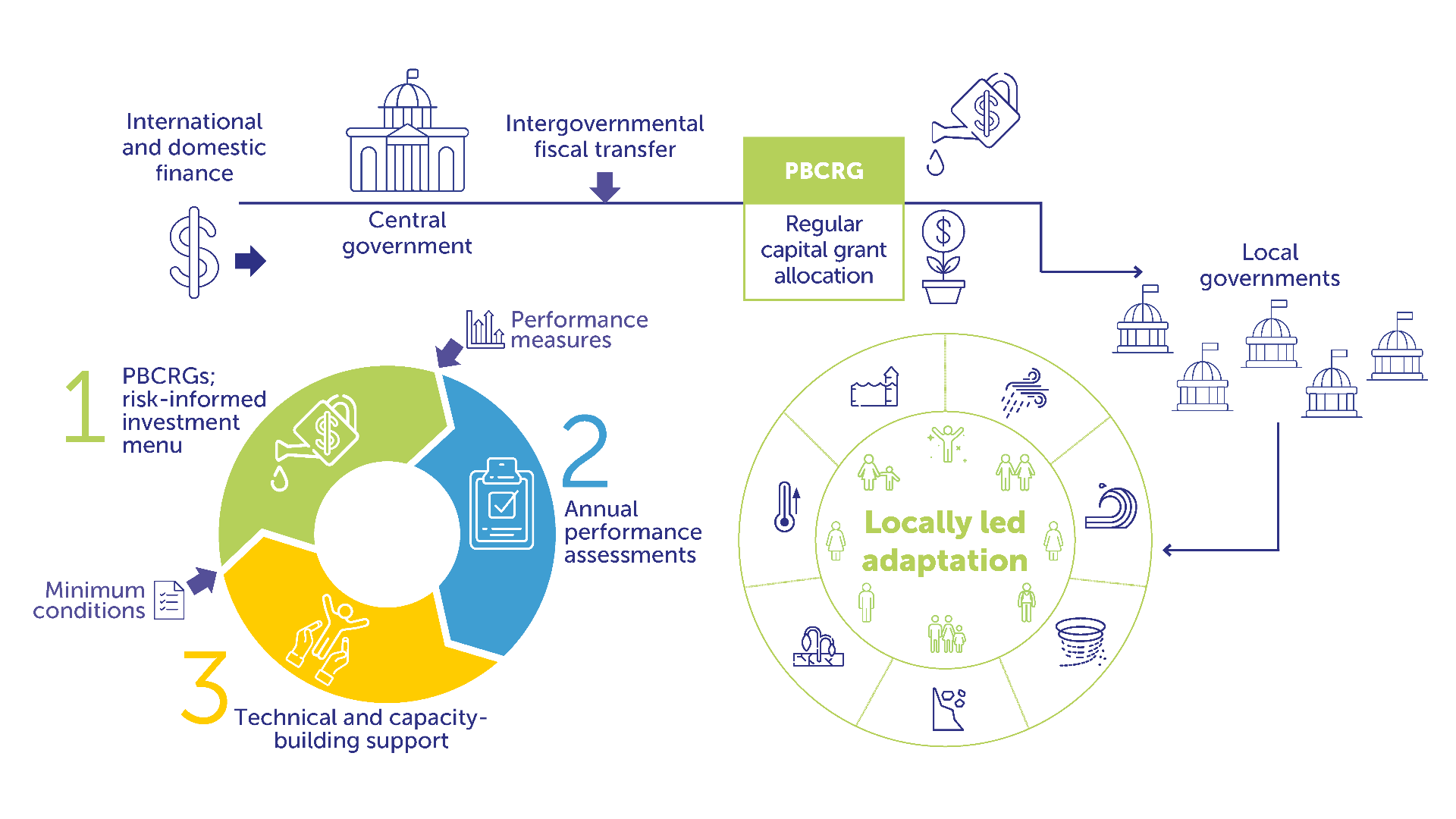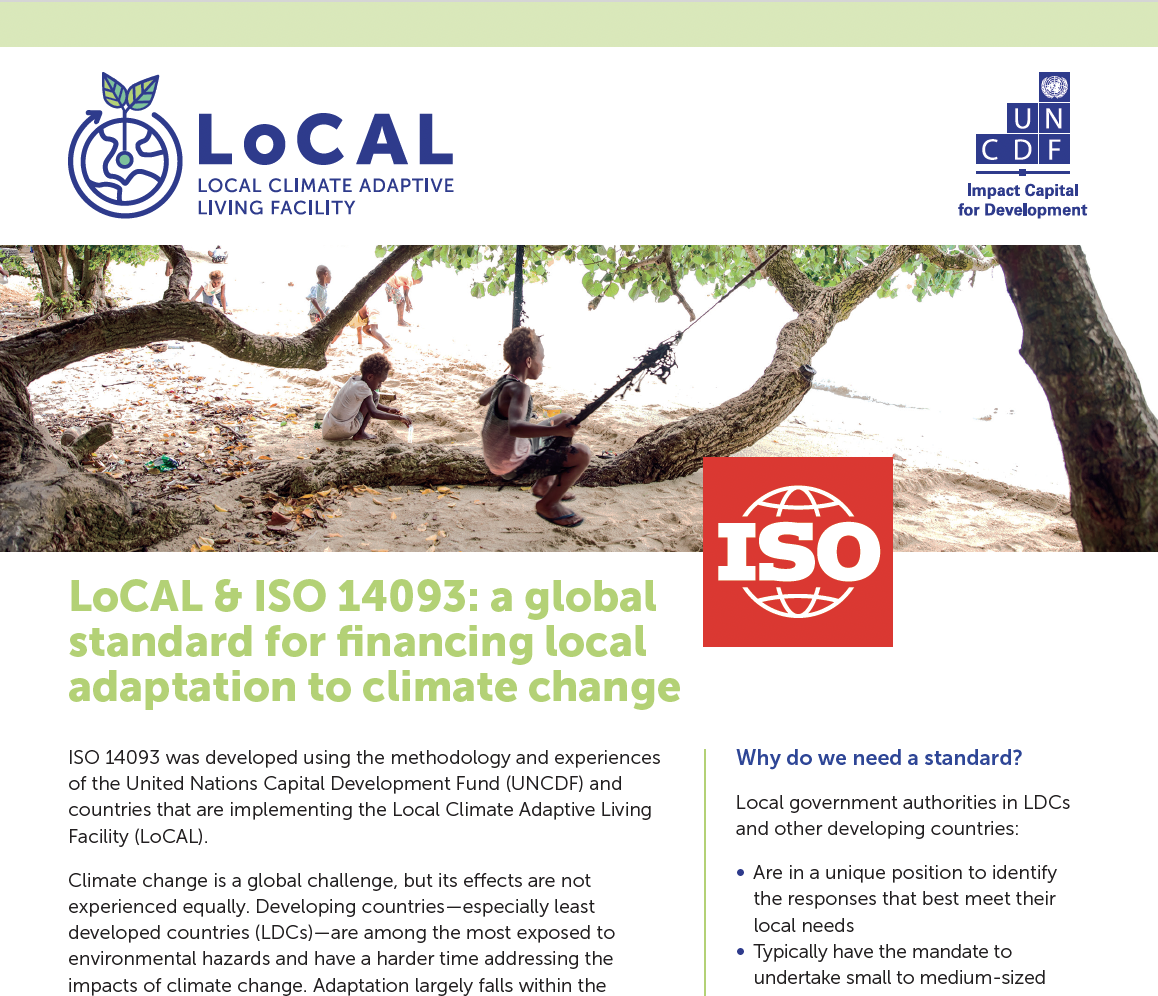
Performance-Based Climate Resilience Grants
LoCAL applies principles of fiscal decentralization and effective local planning and public financial management to climate change. It combines performance-based climate resilience grants (PBCRGs), which ensure programming and verification of climate change expenditures at the local level, with technical and capacity-building support.
Performance-based climate resilience grants finance the additional costs of making investments climate resilient, and are channelled through existing government fiscal transfer systems (rather than parallel or ad hoc structures). International climate finance is channelled through national treasuries — right down to the local level. National ministries are involved in regulating the system.
Once designed, delivering performance-based climate resilience grants typically involves these key steps:
- Climate information and vulnerability and adaptation assessments are reviewed or undertaken to inform the process. Needs and capacities are assessed.
- In a participatory manner, local governments develop local adaptation plans or programmes, integrate adaptation in their own local development planning and budgeting processes, and cost and select adaptation measures to be financed through the grant.
- Grants are disbursed to support implementation of LoCAL investments in the context of local authorities’ annual planning and budgeting cycles, and selected measures are implemented.
- Performance is appraised in terms of the degree to which additional resources have been used to build resilience and promote adaptation to climate change.
- Audits are undertaken as part of the regular national process. The assessment results inform subsequent allocations, and the process provides an opportunity for capacity building.
Capacity-building activities are undertaken at various stages according to identified needs; they target the policy, institutional and individual levels. Often, local governments work with partners that support the capacity building and planning necessary to mainstream adaptation into the decision-making process. These local partners vary by case, but can include other projects and programmes that address adaptation, resilience and environmental issues more broadly. Identifying partners is part of the scoping work in establishing LoCAL in a given country.

The LoCAL PBCRG Principle
LoCAL grants are disbursed as part of a local government’s regular budget envelope and can thus finance the adaptation element of larger investments, allowing for holistic responses to climate change. The funds provide an incentive for local governments to integrate adaptation and climate-proof local development. In addition, by tracking small funds allocated at the local level, LoCAL helps improve transparency.
In any country, LoCAL begins by scoping and designing the performance-based grants for climate resilience system and its key components. This entails defining the financial circuit to channel the funds to the local level and the institutional set-up; defining the size of the grants and the allocation formula; selecting the minimum conditions (including aligning them with existing systems); developing performance measure criteria, with a focus on climate change adaptation and related country priorities; and defining the indicative menu of eligible investments that informs the integration process
Minimum conditions are generally concerned with public financial management and good governance. Performance measures are more qualitative and variable measures of performance; they typically go into more detail within each functional area, such as the quality of the planning or the quality of climate change management, etc. The measures are used to adjust the level of funds made available to local governments when they have complied with the minimum conditions.
The menu of eligible investments defines areas of action that are appropriate for local government intervention. They vary according to climate change impacts, ecosystems, and possible local responses taking into account local constraints such as the financial absorption capacity of the local market. Developing the menu usually involves the use of secondary data and existing vulnerability studies, in addition to primary data collection if necessary. Performance-based grants for climate resilience need to be large enough to have an impact but small enough to be fiscally sustainable and scalable.
LoCAL, the Global Standard for Financing Local Adaptation to Climate Change
In 2022, ISO 14093:22 “Mechanism for financing local adaptation to climate change — Performance based climate resilience grants — Requirements and guidelines”, was developed using the methodology and experiences of the UN Capital Development Fund (UNCDF) and countries implementing the Local Climate Adaptive Living, or LoCAL Facility.
ISO 14093 establishes an approach and methodology for a country-based mechanism to channel climate finance to subnational authorities to support climate change adaptation and to increase local resilience, contributing to the achievement of the goals of the 2015 Paris Agreement of the United Nations Framework Convention on Climate Change (UNFCCC) and the UN Sustainable Development Goals (SDGs). The country-based mechanism uses performance-based climate resilience grants (PBCRGs), which ensure programming and verification of climate change expenditures at the local level and offer strong incentives for performance improvements in enhanced resilience.
Who are the users of this standard?
ISO 14093:22 is applicable to organizations such as national and subnational authorities, donors, companies, financial institutions and international organizations that are involved in implementing a country-based mechanism for channeling climate finance to subnational authorities to support climate change adaptation and resilience.
Download our flyer for more details:
LoCAL & ISO 14093: a global standard for financing local adaptation to climate change
Our partners

Find us on the UNCC:Learn platform
Discover the latest LoCAL training course, co-produced with UNITAR
Stay Connected
GET THE LATEST UPDATES TO YOUR INBOX
